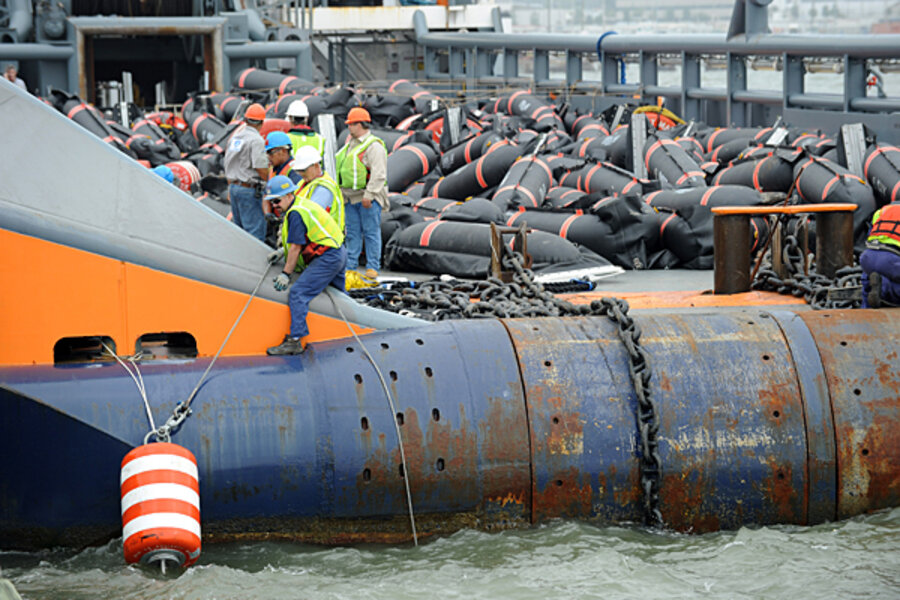Current timeline to shut down Gulf of Mexico oil spill: three months
Loading...
Federal officials speaking about the Gulf of Mexico oil spill Sunday morning appeared to be steeling the Louisiana coast – and the nation – for consequences that could be “catastrophic.”
The officials, who run the agencies charged with mitigating the impact of the spill on America’s Gulf coast, used unusually stark words to describe the situation and the difficulties of the remedy.
Interior Secretary Ken Salazar said it was the federal government’s job to “keep the boot on the neck of BP,” which is running the cleanup effort.
IN PICTURES: Louisiana oil spill
Coast Guard Commandant Thad Allen called the bid to shut down a wellhead spewing at least 210,000 gallons of oil a day from nearly a mile beneath the ocean surface “one of the most complex things we’ve ever done.”
He went on to say that, in a worst-case scenario, the well could vent 4.2 million gallons of oil into the Gulf daily. Currently, a crumpled “riser” pipe is preventing the full flow of oil – like a kinked garden hose – though reports suggest it is gradually deteriorating.
The comments were prelude to President Obama arriving in Louisiana Sunday to assess the situation.
How to shut down the well?
Both the comments and Mr. Obama’s impromptu visit suggest that the White House is trying to head off the criticisms that befell the Bush administration after hurricane Katrina – that it was slow to engage federal agencies.
Yet they also gave the impression of a government facing a challenge of such complexity and enormity that it was not sure what, really, could be done to shut down the source of the disaster in the short term.
“The spill is indeterminate,” said Allen on CNN’s “State of the Union.”
Unlike the Exxon Valdez disaster, where a tanker with a known amount of oil ran aground off Alaska, an oil pocket was opened when the Deepwater Horizon oil rig sank after exploding April 20. All that is preventing the free flow of oil – which could amount to tens of millions of gallons – is the kinked riser pipe, which is springing leaks.
The Exxon Valdez released 11 million gallons of oil in 1989. The Deepwater Horizon accident has so far leaked about 1.6 million gallons of oil, the Coast Guard estimates.
The “ultimate relief,” said Secretary Salazar, was to drill a relief well. But that was still “90 days out,” he added, also speaking on “State of the Union.”
The result is that, as the oil increases, pushing closer to Gulf coast shores, no one appears to have an idea of how to shut off the tap.
'Inner space'
The difficulty is the depth of the wellhead. Once the emergency mechanisms designed to shut down the wellhead failed, BP entered uncharted territory.
No emergency oil operation has ever been carried out at 5,000 feet below the sea. Human divers would be killed at such a depth, and the water pressure is so great that only certain equipment can withstand it.
Comparing it with the difficulties of outer space exploration, Allen called this realm of the deep sea “inner space.”
Yet until the wellhead is shut down, both BP and the federal government will merely be trying to limit the damage. With environmental, economic, and political pressure mounting, however, the federal government appears to be taking more authority upon itself.
“BP is the responsible party,” says Department of Homeland Security Secretary Janet Napolitano on “State of the Union.” “They’re responsible for getting the well shut off with oversight from the Coast Guard.”
But, she added, “the Coast Guard has taken on a lot of the operational duties.”
IN PICTURES: Louisiana oil spill
Related:
Irked by BP, Gulf of Mexico towns mull Plan B to halt oil spill
C'mon, how big is the Gulf of Mexico oil spill, really?
With Katrina comparisons inevitable, Obama plans oil spill visit





